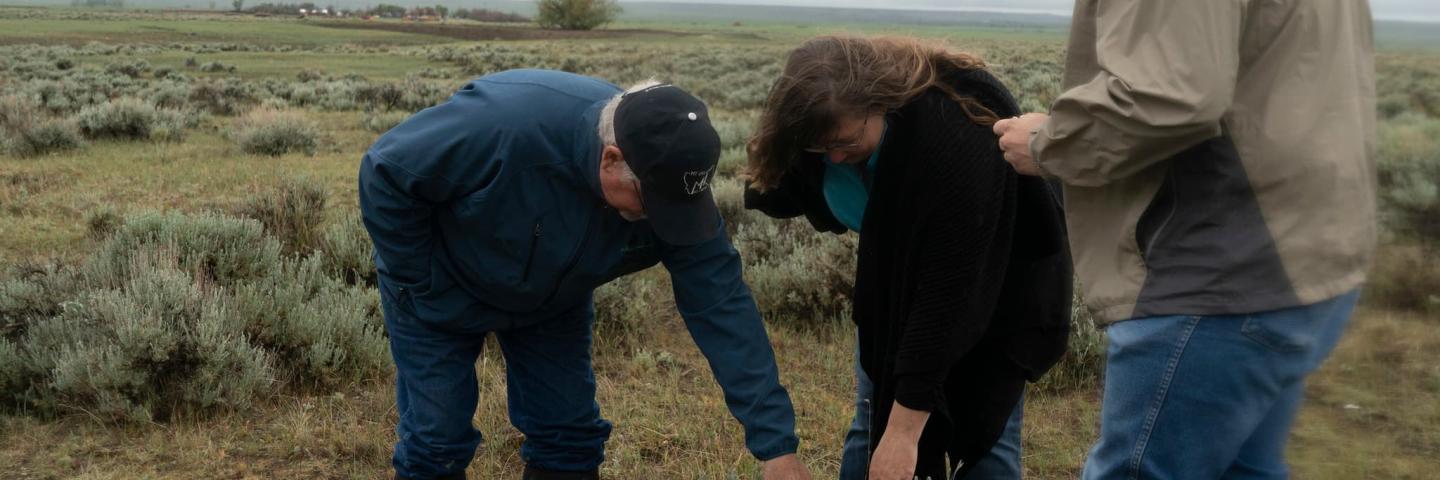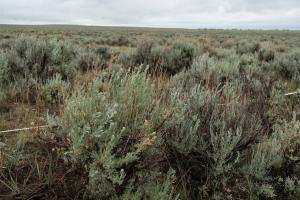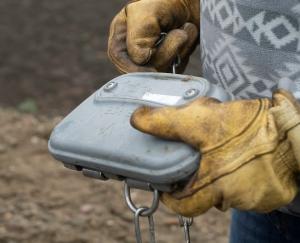Seeds of Community

The Barthelmess Ranch near Malta, Montana offers a beautiful landscape of sagebrush and hardy native grasses. NRCS Montana and partner organizations have assisted the Ranch to create a sustainable grazing model that will help ensure the beautiful landscape remains for years to come.
Looking out across Barthelmess Ranch at the land dotted with sagebrush and hardy native grasses, it’s easy to get swept up in the stark drama of the beautiful view. It’s easy to forget that the key to that landscape lies a bit deeper.
Watch the Barthelmess Ranch story on YouTube: Conservation for the Future: Sustainable Grazing on the Barthelmess Ranch, Phillips County, MT.
“Everything comes down to soil at the end of the day,” says Leo Barthelmess. “If you don’t have good soil, you don’t have good foraging, you don’t have good anything else.”
“It starts with the soil, and then we manage the livestock to support the grasslands that support the soil.”
Barthelmess manages the ranch with his wife, Darla and his brother and sister-in-law, Chris and Deb. The ranch is situated near the town of Malta on the plains of northern Montana. The brothers are the second generation of their family to work this ranch about 75 miles from the Canadian border.
They take after their father and grandfather, who built a family legacy of farming, ranching, and stewardship. Even with three generations of experience, Barthelmess says their neighbors still see them as “young’uns.” Sustaining this land is hard, and many in the area have learned their techniques over a long period of time. For Barthelmess, that only adds to the sense of community.
“There’s no better place to live,” he explains. “Everybody is grounded in the space, in the landscape. Everybody understands their place in this area, you’re all part of a system here. It’s a small community and the loss of even one or two key people would negatively impact the community.”
A Web of Life
In a community as tight as the one around Malta, it’s not just humans playing a major role. The delicate web that sustains the land also has a prominent place for animals, Barthelmess points out.
“Typically, in these arid, brittle environments, if you don’t have an animal out there to periodically harvest the vegetation, and if they don’t put some percentage of that onto the soil surface so the soil biology and the microbes can absorb those nutrients from that, your grasslands just become decadent, and they get covered with so much residue that sunlight can’t get to the growth points.”
“These grasslands evolved over hundreds of thousands of years with large animals grazing them and small animals grazing them,” he says. “Grasshoppers were part of the grazing system and the little bugs and the moles and the voles.”
Many features of Barthelmess Ranch serve as reminders that nature and this landscape are far older than ranches, farms, and property lines. The ranch sits on a massive, historic migratory route used by antelope and deer. That migration makes for a breathtaking sight, but also means that the brothers needed to design their fencing without disrupting that route.
This is just another way in which Barthelmess family thinks systemically about the land, what each part—however small—does to maintain or throw off the ecosystem. This goes not just for the present state of their ranch, but into planning for the future.

“What we’d like to see is more vegetative coverage,” Barthelmess explains. “It doesn’t all have to be livestock forage, but more plants per square foot and less bare ground because that creates a microclimate, where one or two inches off the soil surface it’s cooler or it’s warmer. It just moderates the temperature, so your soil biology works.”
Getting it Done Together
Barthelmess Ranch has worked with the Natural Resources Conservation Service (NRCS) and through them engaged in educational opportunities, received technical assistance, and built partnerships with outside organizations like Pheasants Forever and the Ranchers’ Stewardship Alliance. Barthelmess believes NRCS helped them do more than they could have on their own.
Barthelmess says these relationships have enabled him to learn more effectively than he could with a more hands-off approach. “You can read what you need, but person-to-person communication and onsite mentoring is hugely important,” he says.
“Our office started working with Leo in about 1996, when he came in and requested some help with some cross-fencing,” says Shilo Messerly, NRCS District Conservationist for Malta and surrounding Phillips County. Messerly has been working with Leo and the ranch for years, primarily through the NRCS Environmental Quality Incentives Program (EQIP). The scope of their partnership has only grown.
The Barthelmess family isn’t content to just sit on the knowledge they’ve gained through their partnerships with NRCS and others. They’re committed to creating opportunities for others to benefit from what they’ve learned. Especially since that sort of cooperation has helped them weather trials in the past.
“We’ve hosted a range monitoring workshop here at the ranch, and a lot of the instructors were from the NRCS,” says Barthelmess. “We didn’t have that opportunity in the sixties to learn that stuff. Then in the seventies and especially the eighties, when the drought and the financial distress created all these needs to do better, NRCS was there to help the ranchers and the farmers.”
Embracing New Technology

Barthelmess Ranch has recently embraced new technology to create virtual fencing to humanely control grazing rotations without needing to rely solely on barbed wire. This has also meant they get to implement smart rotational grazing without disrupting the deer and antelope migration route that runs through the ranch.
The virtual fences have been so effective that other producers are taking notice. Barthelmess says he fields calls every week from fellow ranchers looking for advice and guidance on implementing the technology on their own land. He believes it’s made a big impact for them.
“We subdivided two pastures into five pastures and went from a 60-day grazing rotation in the spring in the two pastures to a seven to 14-day rotation in the five pastures. The immediate result of that was an increase of 50% in the amount of time we can spend in that and still have more grass than we ever did before.”
Just like with the educational work they’ve done together, Barthelmess credits NRCS with helping to make the physical infrastructure improvements on the ranch. NRCS has helped Barthelmess Ranch with controlled rangeland burns to address vegetative issues, drilling wells, putting in barbed wire where electronic fences weren’t viable, and providing other tools to manage grazing land.
“Margins on ranch operations are very small and without the NRCS financial assistance and technical assistance, a lot of the innovations that we use at the ranch wouldn’t have been possible,” said Barthelmess.
Engaging Their Neighbors
The progress made by operations like Barthelmess Ranch has not been frictionless. In the early 2000s, ranchers got together to express their anxieties after plots of land were bought by the Nature Conservancy. However, the locals soon realized that by engaging with conservation attempts and being part of the process, they not only had a voice, but they built better relationships with outside organizations.
Out of that coming together grew the Ranchers’ Stewardship Alliance (RSA), who work to build and support ranching, conservation, and community. This cooperation and aid is a key part of the mission of RSA, Barthelmess Ranch, and many members of the community.
“The Ranchers’ Stewardship Alliance has grown into a resource for farmers and ranchers in our community,” says Messerly. “NRCS has specific programs that can help with different conservation issues, but sometimes there’s more interest and more need out there than NRCS can actually fund and give that assistance to. So, the Ranchers’ Stewardship Alliance has been able to bring in resources and help assist with that.”
“There’s gonna be droughts and floods and fires. The children of the future, the next generation, they’re gonna have to work together to solve these problems,” said Barthelmess. “That’s the biggest thing. That’s what I’ve learned mostly in my life in the last twenty years with the RSA, that we’re a lot stronger as a team than we are as individuals.”
“We have a lot more in common than we have not in common,” Barthelmess says. “Let’s focus on the pieces we can work together on.”
More Information
To learn more about NRCS conservation assistance, please visit your local field office or NRCS - Montana, where you can also find contact information for the office in your county.

